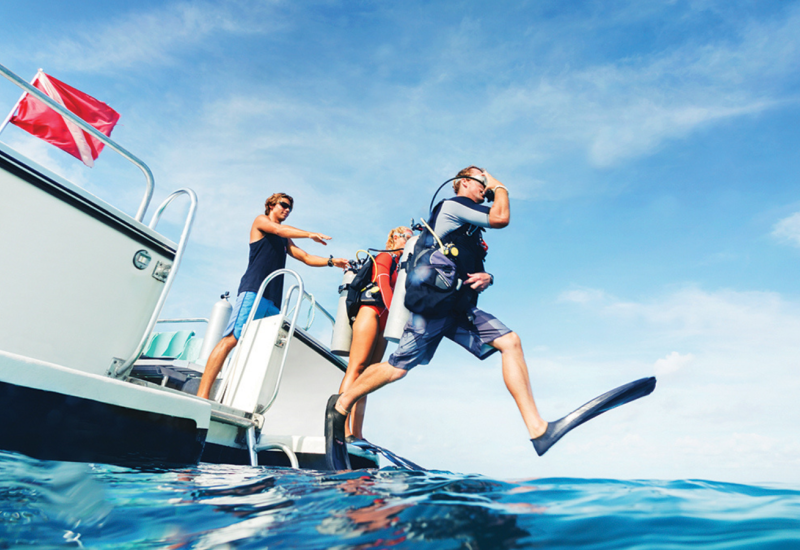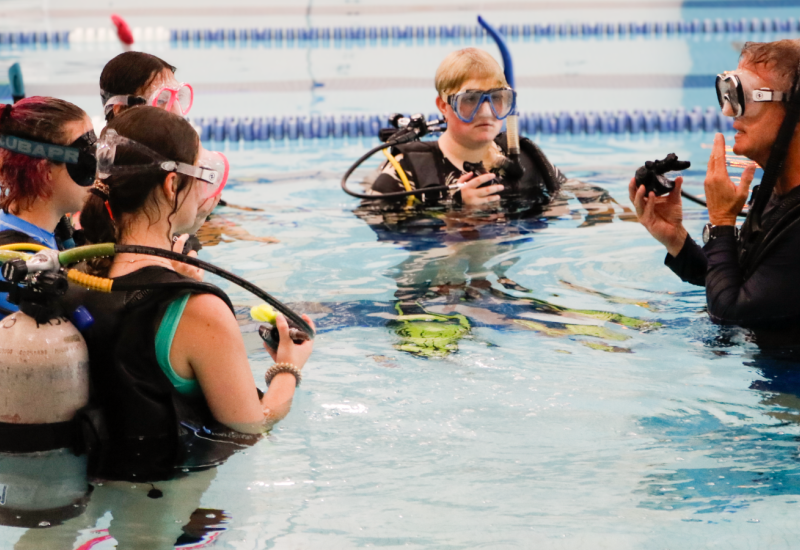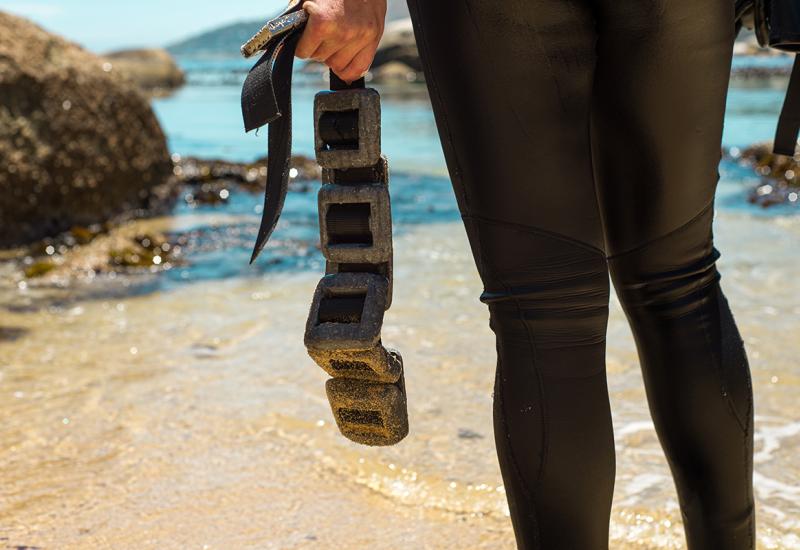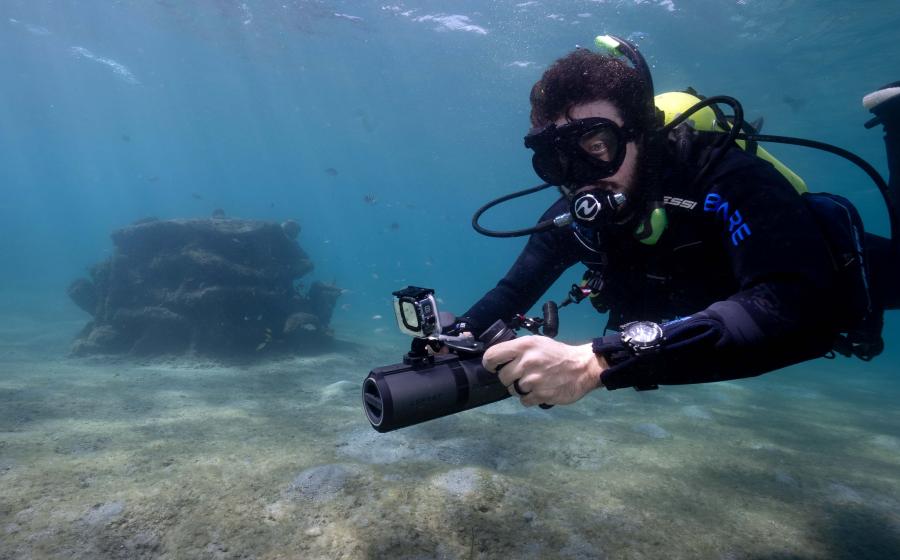What to Do When You Surface Down Current from The Dive Boat

Too far a swim back to the boat? Stay calm.
Tanya Burnett
On a recent dive trip to California's Catalina Island, the boat captain decided to take me and my fellow divers to the backside of the island, a rare treat as wind and currents usually make dives in this area nearly impossible. My buddy and I were the first in the water, and we had a comfortable dive. When we noticed the currents shifting, we decided to head back to the boat. Climbing back on board, we looked around to see divers surfacing far down current. No one came up anywhere near the boat, and they all had serious trouble making their way back. My buddy, a competitive swimmer, jumped back in the water and began towing divers to the boat. I stayed topside and helped them climb on board. Thanks to cool heads and quick reactions, everyone eventually made it back to the boat unharmed.
Surfacing down current from the dive boat is not usually an emergency by itself, but if not handled properly, this mistake can lead to panic, exhaustion, hypothermia and other potentially deadly problems. The good news is that staying aware of your surroundings and planning your dives properly can help you avoid this mistake most of the time. However, if you do end up downstream and can't make it back to the boat, here are six steps for getting rescued.
Don't Fight the Current
Unless the current is mild, fighting against it may prove nearly impossible. Swimming diagonally across a current is one way to close the gap between you and the boat, perhaps getting you close enough to grab a life preserver or tag line. Currents are also much weaker along the bottom, so if you have enough air and the bottom below the boat is relatively shallow, you can go back down and try to get back that way. If neither of these options will work, be realistic. It doesn't make sense to exhaust yourself fighting a current you can't beat. Instead, conserve your energy and focus on alerting the boat crew to your situation. Your job at this point is relatively simple. Get buoyant by inflating your BC, dropping your weights or both, if necessary. Then look around for your boat or any other potential rescue vessels.
Signal for Help
You can't get rescued if no one knows where you are, so the next step is getting yourself noticed. Even in relatively calm seas, divers on the surface are hard to see as they bob up and down with the swells. The key to getting noticed is becoming taller, brighter and louder. Many dive professionals recommend carrying both visible and audible signaling devices on every dive.
Visible signals like safety sausages or signal mirrors not only get the attention of the boat crew, they also help them keep you in sight until they can come to the rescue. When using a safety sausage or other inflatable surface marker, make sure to hold it as vertical and tall as possible. If you lay it on its side in the water, it's not much more visible than you are.
Audible signaling devices, like air-powered alert horns or even old-fashioned whistles, work great for getting someone's attention. Point your horn or whistle blast in the direction of the boat, and signal at regular intervals. Intensify your efforts if you see the boat crew has not spotted you. Remember, audible devices are more effective when signaling boats downwind of your position.
Once the boat crew has spotted you, you should let them know you're all right and help them keep visual contact. "Give a large, two-arm surface OK to the boat," says Tec Clark, the chief operating officer for Ft. Lauderdale's Pro Dive International. "Hold the OK until you know the boat crew has seen you. Then take your surface marker, or a brightly colored fin, and hold it in the air above you, but don't wave the tube or fin unless you need immediate assistance."
Keep Calm and Get Comfortable
While you wait on the surface, the best thing you can do is keep your cool. A savvy boat captain can calculate current, wind, wave action and time and come pretty close to tracking a drifting diver's path and position. If you alert the crew and they make visual contact with you, you'll have a good chance of getting picked up even if they can't come right away because they're waiting for the rest of the divers to climb on board.
In the meantime, keep a regulator or snorkel in your mouth and your mask in place to avoid getting water in your mouth, nose or eyes. And so you don't exhaust yourself trying to stay on the surface, get positively buoyant by inflating your BC, but don't put too much air in your vest. Jacket-style BCs can squeeze your chest and stomach when overinflated, making it hard to breathe properly, and back-mounted BCs tend to push divers either face up or face down when fully inflated. Deflate your BC until it fits comfortably. If this isn't enough to float you on the surface, drop your weights or any other items that might be weighing you down. Nothing, not a goody bag full of lobsters or even your camera, is worth dying for.
Keep an Eye on Your Boat
If you've been swept away, your ultimate goal is to make it back to your original boat. If the people you're diving with know you've drifted away but not that you've been rescued, they will likely continue looking for you, causing unnecessary search operations, possibly involving local search-and-rescue or Coast Guard personnel.
If you can safely swim to another boat, or if another boat offers to pick you up, take care of your immediate needs and get on board, but have the captain arrange a rendezvous so your dive boat can come pick you up. If you're certain that your original boat is on the way, you may choose to grab a tag line from the closest vessel and wait, but make sure to communicate your situation to the crew of the new boat and tell them who you were originally diving with so they can pass the word along.
Stay Warm
Even when you're wearing adequate thermal protection for the diving conditions, you can lose a lot of body heat to the water by the end of your dive. Add a few hours floating on the surface and you could get dangerously cold, even hypothermic, especially if you're somewhere subtropical like California or if daylight is running out.
If it's taking the boat a long time to come after you, use the Heat Escape Lessening Posture (HELP) to hold onto your body heat by minimizing the surface area of your body that's exposed to the water. Essentially, you curl into a ball on the surface holding your knees close to your chest with your arms. This position will minimize exposure to your head, armpits and groin, the parts of your body that give off the most heat. If you're with other divers, you can huddle together. A group hug may not curb heat loss as effectively as the HELP method, but human contact goes a long way toward boosting morale and keeping everyone calm.
If you're still getting cold and fear the onset of hypothermia, which starts as shivering but can lead to mental confusion and unconsciousness, immediately drop your weights if you haven't already done so. Secure your surface marker by looping the lanyard around your leg or clipping it to your BC so it'll stay with you and remain visible all by itself--even if your numb fingers can't hold it.
Prevent It
As with most situations, the best solution to this problem is proper planning and prevention. Always listen to the dive briefing, follow the crew's instructions and start your dive swimming into the current so you can go with the flow when it's time to head back. You'll use less energy, air and time returning than you did going out, bringing you back to the boat with plenty of all three. You'll get to burn a few hundred psi under the boat, go up for a leisurely safety stop and then climb back on the boat like a pro.
To avoid losing track of where you are in relation to the boat or overshooting it when you float back on the current, make sure to keep your navigation skills sharp as well. You don't have to whip out your compass every time you dive to navigate effectively. Make it your habit to practice natural navigation by picking out undersea landmarks along the way. Swim slowly, and mentally note oddly shaped rocks and brightly colored corals that stand out from the rest, or even use small rocks to arrange arrows in sand patches so you can follow them like breadcrumbs back to the boat.
Accidents do happen, however, and should you find yourself swept away, keeping calm and in control of yourself is the most important thing you can do.
Tec Clark sums it up like this: "The big thing is not to panic. Don't let doubt or fear enter your mind or start thinking about Jaws or Open Water. Simply float and keep your eye on the boat and your surroundings. Invest in a surface signaling device or two and do what you've been taught to do. If you can remember all that, you'll have a great story for happy hour."
Getting Noticed
The pros and cons of various surface signaling devices.
Most signaling devices fit neatly into a BC pocket, clip comfortably to a D-ring or attach unobtrusively to an inflator hose, so there's no excuse for not having them--and, yes, that's "them," plural. Carrying both a visible and audible device will maximize your chances of rescue in a swept-out-to-sea situation. Scuba Lab Director Bill Kendig, who carries a signal tube, mirror and whistle on every dive, helps us explain.
Visible vs. Audible: Sounding the alert with a horn or whistle will get you noticed faster than flying a safety float because an audible blast commands immediate attention, Kendig says. The downside: rescuers can't see sound. That's why visible devices are useful, offering an eye-catching reference that reveals your exact position. "A good boat crew will hear your alert and start searching down current," Kendig says. "Eventually, they'll see your tube."
Safety Floats vs. Signal Mirrors: A brightly colored float provides a constant fix on your position--if it's spotted. "Surprisingly, a signal tube is really only visible for half a mile," Kendig says. A signal mirrors allows you to aim a flashing, attention-getting signal that can be seen for miles. "Mirrors are like the brightest halogen light you've ever seen when they're aimed at you," Kendig says. Both are inexpensive and fit in your BC pocket.
Air Horns vs. Whistles: Both provide an ear-piercing alert within their range. Air horns reach farther, some twice as far as the best whistles, according to a recent Scuba Lab test of signaling devices.
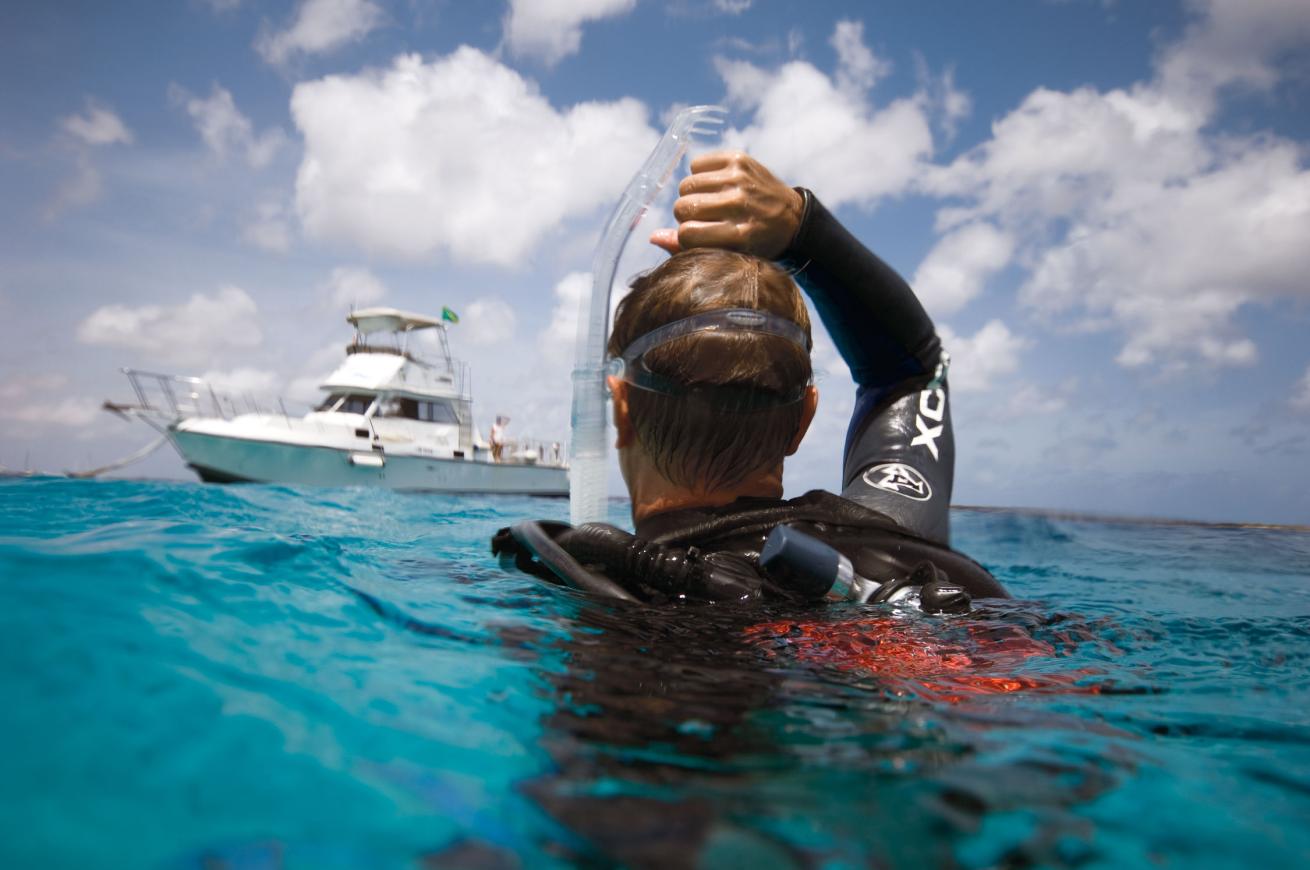
Tanya BurnettToo far away to swim back to the boat? Stay calm.
On a recent dive trip to California's Catalina Island, the boat captain decided to take me and my fellow divers to the backside of the island, a rare treat as wind and currents usually make dives in this area nearly impossible. My buddy and I were the first in the water, and we had a comfortable dive. When we noticed the currents shifting, we decided to head back to the boat. Climbing back on board, we looked around to see divers surfacing far down current. No one came up anywhere near the boat, and they all had serious trouble making their way back. My buddy, a competitive swimmer, jumped back in the water and began towing divers to the boat. I stayed topside and helped them climb on board. Thanks to cool heads and quick reactions, everyone eventually made it back to the boat unharmed.
Surfacing down current from the dive boat is not usually an emergency by itself, but if not handled properly, this mistake can lead to panic, exhaustion, hypothermia and other potentially deadly problems. The good news is that staying aware of your surroundings and planning your dives properly can help you avoid this mistake most of the time. However, if you do end up downstream and can't make it back to the boat, here are six steps for getting rescued.
Don't Fight the Current
Unless the current is mild, fighting against it may prove nearly impossible. Swimming diagonally across a current is one way to close the gap between you and the boat, perhaps getting you close enough to grab a life preserver or tag line. Currents are also much weaker along the bottom, so if you have enough air and the bottom below the boat is relatively shallow, you can go back down and try to get back that way. If neither of these options will work, be realistic. It doesn't make sense to exhaust yourself fighting a current you can't beat. Instead, conserve your energy and focus on alerting the boat crew to your situation. Your job at this point is relatively simple. Get buoyant by inflating your BC, dropping your weights or both, if necessary. Then look around for your boat or any other potential rescue vessels.
Signal for Help
You can't get rescued if no one knows where you are, so the next step is getting yourself noticed. Even in relatively calm seas, divers on the surface are hard to see as they bob up and down with the swells. The key to getting noticed is becoming taller, brighter and louder. Many dive professionals recommend carrying both visible and audible signaling devices on every dive.
Visible signals like safety sausages or signal mirrors not only get the attention of the boat crew, they also help them keep you in sight until they can come to the rescue. When using a safety sausage or other inflatable surface marker, make sure to hold it as vertical and tall as possible. If you lay it on its side in the water, it's not much more visible than you are.
Audible signaling devices, like air-powered alert horns or even old-fashioned whistles, work great for getting someone's attention. Point your horn or whistle blast in the direction of the boat, and signal at regular intervals. Intensify your efforts if you see the boat crew has not spotted you. Remember, audible devices are more effective when signaling boats downwind of your position.
Once the boat crew has spotted you, you should let them know you're all right and help them keep visual contact. "Give a large, two-arm surface OK to the boat," says Tec Clark, associate director for aquatics and scuba diving at Nova Southeastern University in Fort Lauderdale, Florida. "Hold the OK until you know the boat crew has seen you. Then take your surface marker, or a brightly colored fin, and hold it in the air above you, but don't wave the tube or fin unless you need immediate assistance."
Keep Calm and Get Comfortable
While you wait on the surface, the best thing you can do is keep your cool. A savvy boat captain can calculate current, wind, wave action and time and come pretty close to tracking a drifting diver's path and position. If you alert the crew and they make visual contact with you, you'll have a good chance of getting picked up even if they can't come right away because they're waiting for the rest of the divers to climb on board.
In the meantime, keep a regulator or snorkel in your mouth and your mask in place to avoid getting water in your mouth, nose or eyes. And so you don't exhaust yourself trying to stay on the surface, get positively buoyant by inflating your BC, but don't put too much air in your vest. Jacket-style BCs can squeeze your chest and stomach when overinflated, making it hard to breathe properly, and back-mounted BCs tend to push divers either face up or face down when fully inflated. Deflate your BC until it fits comfortably. If this isn't enough to float you on the surface, drop your weights or any other items that might be weighing you down. Nothing, not a goody bag full of lobsters or even your camera, is worth dying for.
Keep an Eye on Your Boat
If you've been swept away, your ultimate goal is to make it back to your original boat. If the people you're diving with know you've drifted away but not that you've been rescued, they will likely continue looking for you, causing unnecessary search operations, possibly involving local search-and-rescue or Coast Guard personnel.
If you can safely swim to another boat, or if another boat offers to pick you up, take care of your immediate needs and get on board, but have the captain arrange a rendezvous so your dive boat can come pick you up. If you're certain that your original boat is on the way, you may choose to grab a tag line from the closest vessel and wait, but make sure to communicate your situation to the crew of the new boat and tell them who you were originally diving with so they can pass the word along.
Stay Warm
Even when you're wearing adequate thermal protection for the diving conditions, you can lose a lot of body heat to the water by the end of your dive. Add a few hours floating on the surface and you could get dangerously cold, even hypothermic, especially if you're somewhere subtropical like California or if daylight is running out.
If it's taking the boat a long time to come after you, use the Heat Escape Lessening Posture (HELP) to hold onto your body heat by minimizing the surface area of your body that's exposed to the water. Essentially, you curl into a ball on the surface holding your knees close to your chest with your arms. This position will minimize exposure to your head, armpits and groin, the parts of your body that give off the most heat. If you're with other divers, you can huddle together. A group hug may not curb heat loss as effectively as the HELP method, but human contact goes a long way toward boosting morale and keeping everyone calm.
If you're still getting cold and fear the onset of hypothermia, which starts as shivering but can lead to mental confusion and unconsciousness, immediately drop your weights if you haven't already done so. Secure your surface marker by looping the lanyard around your leg or clipping it to your BC so it'll stay with you and remain visible all by itself--even if your numb fingers can't hold it.
Prevent It
As with most situations, the best solution to this problem is proper planning and prevention. Always listen to the dive briefing, follow the crew's instructions and start your dive swimming into the current so you can go with the flow when it's time to head back. You'll use less energy, air and time returning than you did going out, bringing you back to the boat with plenty of all three. You'll get to burn a few hundred psi under the boat, go up for a leisurely safety stop and then climb back on the boat like a pro.
To avoid losing track of where you are in relation to the boat or overshooting it when you float back on the current, make sure to keep your navigation skills sharp as well. You don't have to whip out your compass every time you dive to navigate effectively. Make it your habit to practice natural navigation by picking out undersea landmarks along the way. Swim slowly, and mentally note oddly shaped rocks and brightly colored corals that stand out from the rest, or even use small rocks to arrange arrows in sand patches so you can follow them like breadcrumbs back to the boat.
Accidents do happen, however, and should you find yourself swept away, keeping calm and in control of yourself is the most important thing you can do.
Tec Clark sums it up like this: "The big thing is not to panic. Don't let doubt or fear enter your mind or start thinking about Jaws or Open Water. Simply float and keep your eye on the boat and your surroundings. Invest in a surface signaling device or two and do what you've been taught to do. If you can remember all that, you'll have a great story for happy hour."

